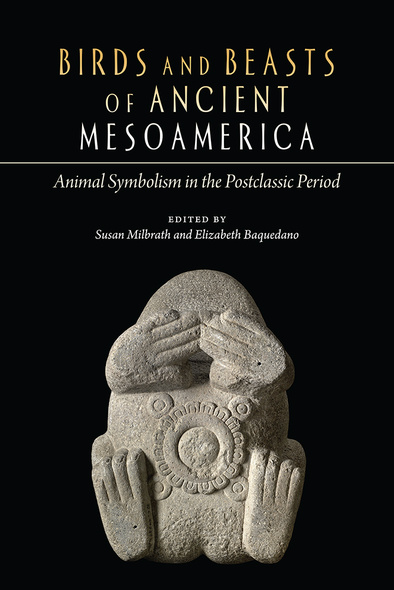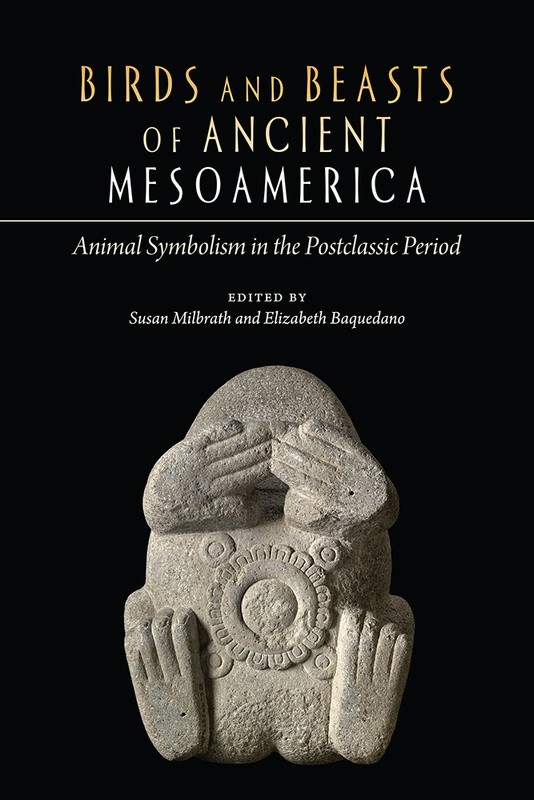Birds and Beasts of Ancient Mesoamerica
Animal Symbolism in the Postclassic Period
Edited by Susan Milbrath and Elizabeth Baquedano
University Press of Colorado
Birds and Beasts of Ancient Mesoamerica links Precolumbian animal imagery with scientific data related to animal morphology and behavior, providing in-depth studies of the symbolic importance of animals and birds in Postclassic period Mesoamerica.
Representations of animal deities in Mesoamerica can be traced back at least to Middle Preclassic Olmec murals, stone carvings, and portable art such as lapidary work and ceramics. Throughout the history of Mesoamerica real animals were merged with fantastical creatures, creating zoological oddities not unlike medieval European bestiaries. According to Spanish chroniclers, the Aztec emperor was known to keep exotic animals in royal aviaries and zoos. The Postclassic period was characterized by an iconography that was shared from central Mexico to the Yucatan peninsula and south to Belize. In addition to highlighting the symbolic importance of nonhuman creatures in general, the volume focuses on the importance of the calendrical and astronomical symbolism associated with animals and birds.
Inspired by and dedicated to the work of Mesoamerican scholar Cecelia Klein and featuring imagery from painted books, monumental sculpture, portable arts, and archaeological evidence from the field of zooarchaeology, Birds and Beasts of Ancient Mesoamerica highlights the significance of the animal world in Postclassic and early colonial Mesoamerica. It will be important to students and scholars studying Mesoamerican art history, archaeology, ethnohistory, and zoology.
Representations of animal deities in Mesoamerica can be traced back at least to Middle Preclassic Olmec murals, stone carvings, and portable art such as lapidary work and ceramics. Throughout the history of Mesoamerica real animals were merged with fantastical creatures, creating zoological oddities not unlike medieval European bestiaries. According to Spanish chroniclers, the Aztec emperor was known to keep exotic animals in royal aviaries and zoos. The Postclassic period was characterized by an iconography that was shared from central Mexico to the Yucatan peninsula and south to Belize. In addition to highlighting the symbolic importance of nonhuman creatures in general, the volume focuses on the importance of the calendrical and astronomical symbolism associated with animals and birds.
Inspired by and dedicated to the work of Mesoamerican scholar Cecelia Klein and featuring imagery from painted books, monumental sculpture, portable arts, and archaeological evidence from the field of zooarchaeology, Birds and Beasts of Ancient Mesoamerica highlights the significance of the animal world in Postclassic and early colonial Mesoamerica. It will be important to students and scholars studying Mesoamerican art history, archaeology, ethnohistory, and zoology.
‘A refreshing update that fills a gap in our current understanding of animal imagery and symbolism in the last centuries before the Spanish conquest.’
—Virginia E. Miller, University of Illinois Chicago
Susan Milbrath is affiliate faculty of the School of Art and Art History at the University of Florida and emeritus curator of Latin American art and archaeology at the Florida Museum of Natural History. She is the author of Star Gods of the Maya and Heaven and Earth in Ancient Mexico and coeditor of Cosmology, Calendars, and Horizon-Based Astronomy in Ancient Mesoamerica.
Elizabeth Baquedano is a Mesoamerican scholar and a senior lecturer at University College London. She also teaches at the Institute of Archaeology and the British Museum. In 2014, she received the Mexican government’s prestigious Ohtli Award, bestowed upon distinguished Mexicans working outside Mexico whose efforts have contributed significantly to enhancing Mexico, particularly the art and archaeology of ancient Mexico. She was elected Fellow of the Society of Antiquaries, London, in 2021 and is the editor of Tezcatlipoca: Trickster and Supreme Deity.
Elizabeth Baquedano is a Mesoamerican scholar and a senior lecturer at University College London. She also teaches at the Institute of Archaeology and the British Museum. In 2014, she received the Mexican government’s prestigious Ohtli Award, bestowed upon distinguished Mexicans working outside Mexico whose efforts have contributed significantly to enhancing Mexico, particularly the art and archaeology of ancient Mexico. She was elected Fellow of the Society of Antiquaries, London, in 2021 and is the editor of Tezcatlipoca: Trickster and Supreme Deity.





